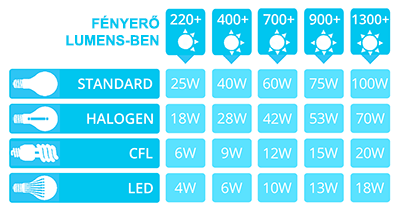Lux vagy Lumens? Mennyi fényre van szükségünk?Ahogy a fotózásnál is elengedhetetlen a megfelelő megvilágítás, más feladatoknál is nagyban befolyásolja a hatékonyságot, termelékenységet és biztonságot, hogy mennyi fénnyel folgozunk. A munka jellege alapvetően meghatározza a szükséges fény mértékét. Ha egy üzletben egy sima izzót vagy egyéb fényforrást, ez lehet egy LED-es zseblámpa is, vásárolunk, akkor gyakran találkozunk lumens (lm) vagy lux (lx) esetleg kandela (cd) értékkel azzal kapcsolatban, hogy az milyen intenzitással világít. Engem is eleinte összezavart, hogy tulajdonképpen ez mit is jelent? Hogyan tudom értelmezni, kézzelfoghatóvá tenni azt, hogy mondjuk egy lámpa 3000 lumens-es?Mit jelent a lux, a lumen, a candela és mi a különbség? A lumen a lámpatest egészéből, minden irányban kisugárzott fény mennyisége, míg a lux pedig a tér egy adott pontjában, egy adott felületre eső fényintenzitás mértékegysége. Minél közelebb kerülünk egy fényforráshoz, annál nagyobb lesz a lux érték. Ha lux-ban edják meg egy fényforrás fényerejét, akkor mindig figyelni kell azt is, hogy milyen távolság érték van hozzá megadva, máskülönben nem tudjuk pontosan meghatározni a fényerejét.  Tipikus értékek, sötét, felhős égbolt esetében kb. 1.000 lux, nem direkt napfényben 10.000 lux, direkt napfényben 100.000 lux négyzetméterenként. A kandela egy irányban a fényerősség. 1 cd körülbelül egy gyertya fényének felel meg, míg egy 100W-os lámpa kb. 120 cd. 1 cd nagyjából 12.57 lumen, bár nem egészen pontos ezt a két értéket így egymáshoz hasonlítani, mert nem teljesen ugyanazt jelenti (ez lehet 1 méter sugarú gömb felületére vagy 12.57 m2-es felületre eső fénymennyiség). Ahogy egy zseblámpánál kevésbé érdekes a lumen érték, a candela fontosabb, mivel a fény egy viszonylag kisebb területen koncentrálódik, míg egy fénycsőnél a lumen érték a magasabb, a kandela pedig kevesebb, mivel nagy területen oszlik el a kisugárzott fény. Tipikus értékek, sötét, felhős égbolt esetében kb. 1.000 lux, nem direkt napfényben 10.000 lux, direkt napfényben 100.000 lux négyzetméterenként. A kandela egy irányban a fényerősség. 1 cd körülbelül egy gyertya fényének felel meg, míg egy 100W-os lámpa kb. 120 cd. 1 cd nagyjából 12.57 lumen, bár nem egészen pontos ezt a két értéket így egymáshoz hasonlítani, mert nem teljesen ugyanazt jelenti (ez lehet 1 méter sugarú gömb felületére vagy 12.57 m2-es felületre eső fénymennyiség). Ahogy egy zseblámpánál kevésbé érdekes a lumen érték, a candela fontosabb, mivel a fény egy viszonylag kisebb területen koncentrálódik, míg egy fénycsőnél a lumen érték a magasabb, a kandela pedig kevesebb, mivel nagy területen oszlik el a kisugárzott fény.Egy lux az egyenlő egy lumen per négyzetméterrel (lux = lumens/m2). A fény szétterjed a sugárzó felületről és minél messzebb kerül a forrástól, annál jobban eloszlik. Éppen ezért lux mértéke függ a megvilágított felület méretétől és a fény beesési szögétől is. Magyarul ha ugyanazon lámpa fényét minél szűkebb területre koncentráljuk, a megvilágított terület annál világosabb lesz, így egyre nagyobb lux értéket kapunk. Itt van egy nagyon hasznos kis fénykalkulátor, amivel könnyen kiszámíthatóak a lumen és a lux értékek a távolság és a fénysugár koncentrálási szögének arányában: Az alábbi táblázatban látható, hogy a kor előrehaladtával hogyan változik és általában mennyi fényre van szükségünk egy munkahelyen különféle feladatok elvégzéséhez:
Forrás: https://www.bannerengineering.com and https://www.shineretrofits.com/ |
















